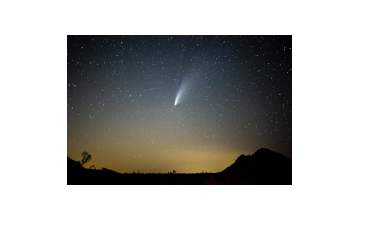- Series:Astronomy, Transcript English
Psalm 19:1
“The heavens declare the glory of God; and the firmament sheweth his handywork.”
 As I write this Creation Moment in 2020, there have been a lot of different news items to catch our eyes. One of the more pleasant pieces of news of this year of disaster has been the visit of Comet Neowise. Since this is the first really bright comet of the social media age, many people were sharing lovely photographs of the object online.
As I write this Creation Moment in 2020, there have been a lot of different news items to catch our eyes. One of the more pleasant pieces of news of this year of disaster has been the visit of Comet Neowise. Since this is the first really bright comet of the social media age, many people were sharing lovely photographs of the object online.
Neowise was discovered on March 27th, 2020, traveling from the outer reaches of the Solar System.
The head or nucleus of the comet is a ball of ice and is probably no more than three miles across. When comets approach the Sun, the stream of gas and ions from the Sun creates a tail which is not pointing away from the direction of motion, but rather pointing away from the Sun. Close to perihelion, the comet produced a second tail. The first was blue, while the second, containing sodium ions, had sodium’s characteristic golden yellow glow.
Comet tails are made of gas and ions. Therefore, the tails, produced on close approach to the Sun, cause the comet to lose material. From this we can calculate that it is impossible for any comet to have lasted more than 100,000 years, and because they are believed to have been formed with the Solar System, this puts an upper bound on the age of the Solar System. While the Solar System could not be older than 100,000 years, it could be younger; for example, it could be 6,000 years as the Bible maintains.
Prayer: Father God, whenever we look into the heavens, we should stop and praise Your Name for Your great glory. Amen.
Author: Paul F. Taylor
Ref: NASA/Goddard Space Flight Center. “Hubble snaps close-up of celebrity comet NEOWISE.” ScienceDaily, 21 August 2020. <www.sciencedaily.com/releases/2020/08/200821134124.htm>. Image: Comet Neowise from Joshua Tree National Park, CC BY-SA 4.0 International.
© 2022 Creation Moments. All rights reserved.
